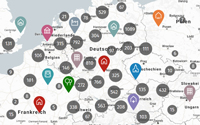
Hertha Hurnaus
The central draft concept was the translation of the versatile and vivid brand into the language of architec-ture. The museum features those specific conditions which the Porsche brand conveys both spatially and sen-sually to visitors. Driving and speed, statics and logjams can be experienced both in the building’s configuration as well as through the spatial medium.
The museum is a clearly defined open place which incorporates all brand spe-cific qualities. Here, speed and passion finds their spatial equivalents and can be impressively retraced in the sensual experience. Experience and the oppor-tunity to experience were the primary design parameters through respective spatial allocations in the basic architec-tural concept. The seeming dicho-tomy of the architectural shape is the appropriate answer to the building’s function and the exceptional posi-tion of its exhibits.
The museum’s conceptual design demonstrates our perception of buildings as interactive organisms, as communicating part of a whole. The consistent interaction between the building and its envi-ronment is conceived as a quality, as is a functional and practical utilisablespace. The specific characteristics of the spatially definable environment are conceived as a landscape or urban landscape, its interpretation as the corporate approach. The Porsche museum is designed as a dynamically formed, monolithic structure, see-mingly detached from the entry level’s folded topography. Its reflective soffit absorbs the architectural landscape below and atmospherically increases the space between base and exhibition area. Thus this architectural gesture underlines the duality of experience and opportunity to experience on which the structural design is based.






